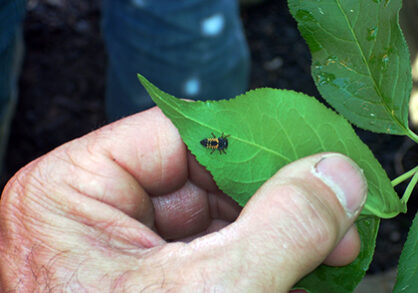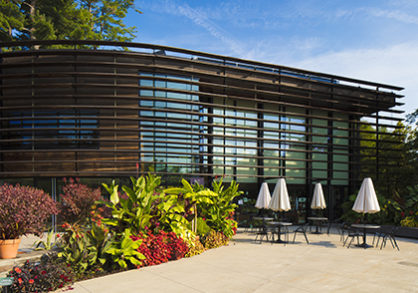Sustainable gardening and landscape practices are showcased throughout Cornell Botanic Gardens. Not only do these practices cut down the use of energy, water, and other resources, they reduce greenhouse gas emissions, which contribute to climate change.
Sustainable Home Garden
Our vegetable garden located near the Nevin Welcome Center demonstrates sustainable practices for the home garden such as attracting insects for pollination and pest control, amending the soil naturally, minimizing pesticide and other chemical use, capturing rainwater, and more. We hope you can visit to learn a few new tips to try at home.
View this short video on what plants you can preserve by pickling.
Pickling for a better world from Cornell Botanic Gardens on Vimeo.
Can’t visit soon? View tips for gardening sustainably “from the ground up” from our interpretive panels.
Gardening for Climate Change
The Climate Change Garden demonstrates how a changing climate affects the plants we grow and how we can adapt our gardens so they continue to thrive.
Download this brochure on ways to adapt your garden to climate change.
Rainwater Management
The Bioswale Garden near the Welcome Center and the Watercourse Garden in the Arboretum were designed to slow down and filter stormwater. Here are some resources for creating these “rain gardens” on a scale for your home landscape.
Plant with Natives
The Mundy Wildflower Garden is a wooded landscape with an exceptional diversity of native plants. Sections of this garden incorporate formal plantings at each entrance to demonstrate ways to landscape with native plants, and provide food, water, and shelter for native pollinating insects and other wildlife.
The Botanic Buzzline is a 980 square foot flowering pathway that connects people and pollinators to the plants within the botanic gardens. It contains more than 45 native or naturalized plant varieties, which appeal to a wide range of pollinators. With a variety of tips and educational signage along the path, the Buzzline encourages people to make their landscapes more pollinator-friendly.
Come to Cornell Botanic Gardens and see what all the buzz is about. from Cornell Botanic Gardens on Vimeo.
Download a list of native plants to attract pollinators in various regions of the U.S. from the Xerxes Society for Invertebrate Conservation.
Native lawn
The native lawn demonstration, located in the Mundy Wildflower Garden, was designed to replace conventional lawn with native low-growing grasses, which only require mowing once or twice per year.
Learn more about the plants grown in this area.
Low Mow Lawn
Reduce emissions by mowing your open lawn or fields only once or twice per year.
The Wonder of Native Pollinator Plants
View this short video with Krissy Boys, native plant specialist, to learn about beautiful native plants and how they nurture pollinator insects and wildlife.
Practice Integrated Pest Management
Minimize the use of chemical pesticides.
Green Building and Infrastructure
We employ green infrastructure—a practice of integrating natural systems into the built environment.


